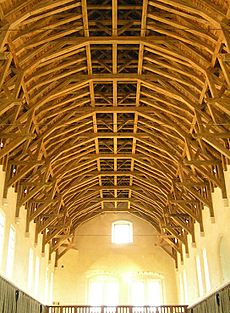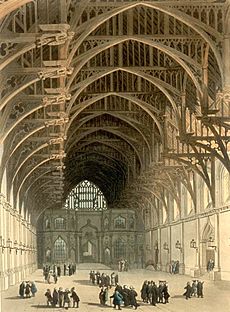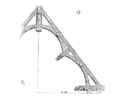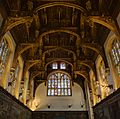Hammerbeam roof facts for kids


A hammerbeam roof is a special type of wooden roof used in buildings. It was very popular during the Gothic era, a time when many grand churches and halls were built. These roofs are famous for their strength and beautiful design. They allow large open spaces inside buildings without needing many support pillars.
Contents
What is a Hammerbeam Roof?
A hammerbeam roof is a clever way to build a wide, open roof using wood. It's like a giant wooden puzzle that holds itself up. These roofs were popular in the Gothic era, especially in England. They allowed builders to create huge, impressive halls.
How Does it Work?
Imagine a normal roof that pushes outwards on the walls. A hammerbeam roof solves this problem. It uses short, horizontal beams called "hammerbeams." These beams stick out from the walls. They don't go all the way across the building.
Instead, the hammerbeams support upright posts called "hammer posts." These posts then hold up the main roof timbers. This design helps to transfer the weight of the roof downwards, not outwards. This means the walls don't need to be super thick to hold the roof up. It also creates a wide, open space below.
The roof often has curved braces that connect different parts. These braces add extra strength and also look very decorative. Sometimes, the ends of the hammerbeams are carved with angels or other figures.
Where Can You See Them?
Hammerbeam roofs are often found in old, important buildings. Many of these are in England.
One of the most famous examples is the roof of Westminster Hall in London. This hall is part of the Houses of Parliament. Its hammerbeam roof was built in the late 1300s. It is one of the largest medieval timber roofs in Northern Europe.
Another great example is at the Great Hall of Stirling Castle in Scotland. This castle has a newly restored hammerbeam roof. It shows how grand these structures can be. You can also find them in many old churches and university halls.
Why Were They Used?
Hammerbeam roofs were used for several important reasons:
- Creating Space: They allowed builders to create very wide, open halls without needing pillars in the middle. This was perfect for large gatherings or ceremonies.
- Strength: Despite looking light, they are incredibly strong. They can support heavy roof tiles and withstand strong winds.
- Beauty: The intricate wooden designs were often carved and decorated. This made the buildings look very impressive and grand.
- Engineering Skill: Building these roofs showed off the amazing skills of medieval carpenters and engineers. They were true masterpieces of their time.
Real vs. Fake Hammerbeams
Sometimes, you might see a roof that looks like a hammerbeam but isn't actually holding up the building. These are called "false hammerbeam roofs." They have the same look but are mostly for decoration. The real support comes from other hidden structures.
An example of a false hammerbeam roof is in the Great Hall of Eltham Palace in England. Another is at Bristol Temple Meads railway station. The hammerbeam elements there are just for show. True hammerbeam roofs are structural, meaning they are essential for holding the roof up.
Images for kids
-
Interior of the Middle Temple hall and its double-hammerbeam roof
-
A modern hammerbeam roof at Windsor Castle
-
A false hammerbeam roof, Angel's roof, St Mary's Church, Bury St Edmunds, Suffolk
-
A false hammerbeam roof in the Great Hall of Eltham Palace, England.
-
A false hammer-beam roof in the Dictionary of French Architecture from the 11th to the 16th Century (1856) by Eugène Viollet-le-Duc
-
The ornamented pendants in the Great Hall of the Wills Memorial Building (University of Bristol), completed in 1925, bombed in 1940 and restored in the 1960s
-
Hampton Court's ornate hammerbeam roof in the Great Hall













